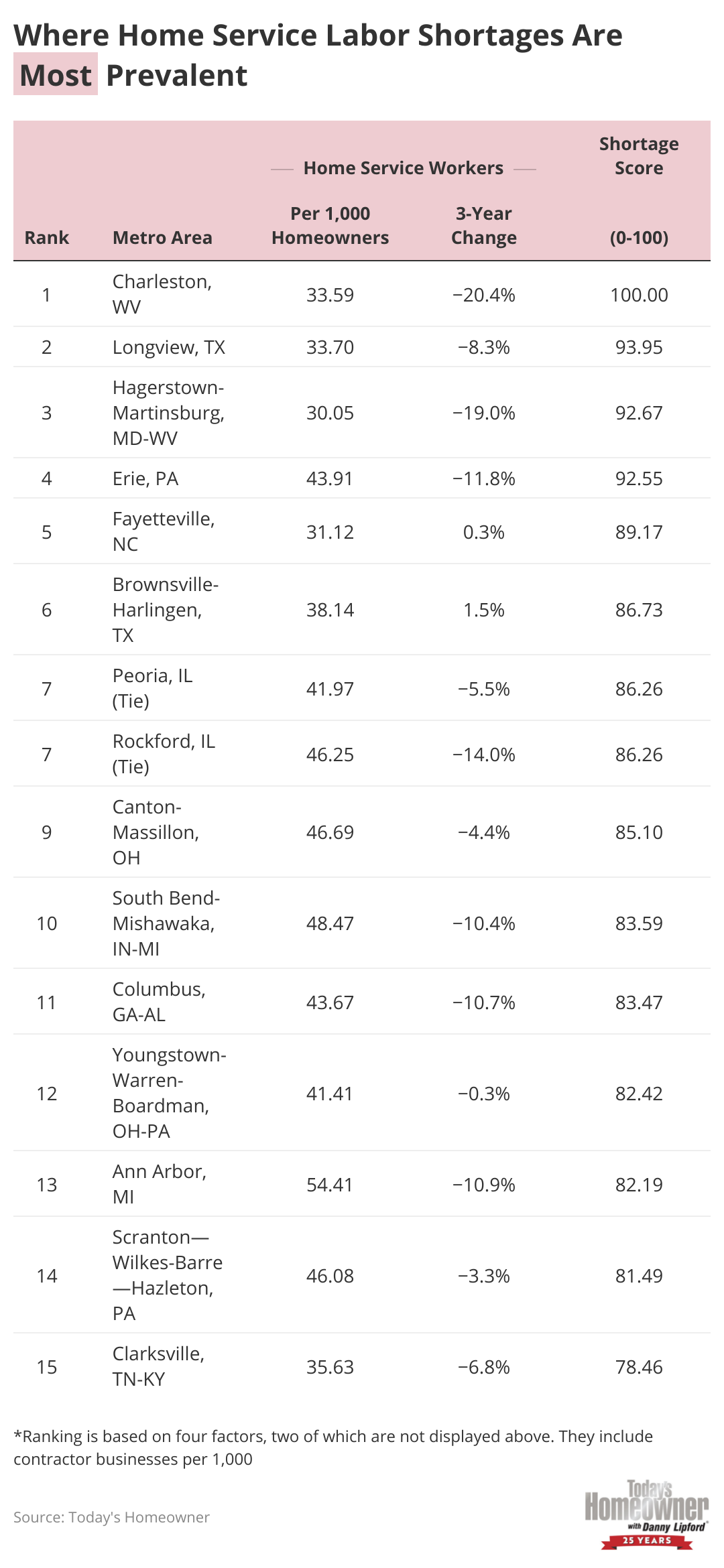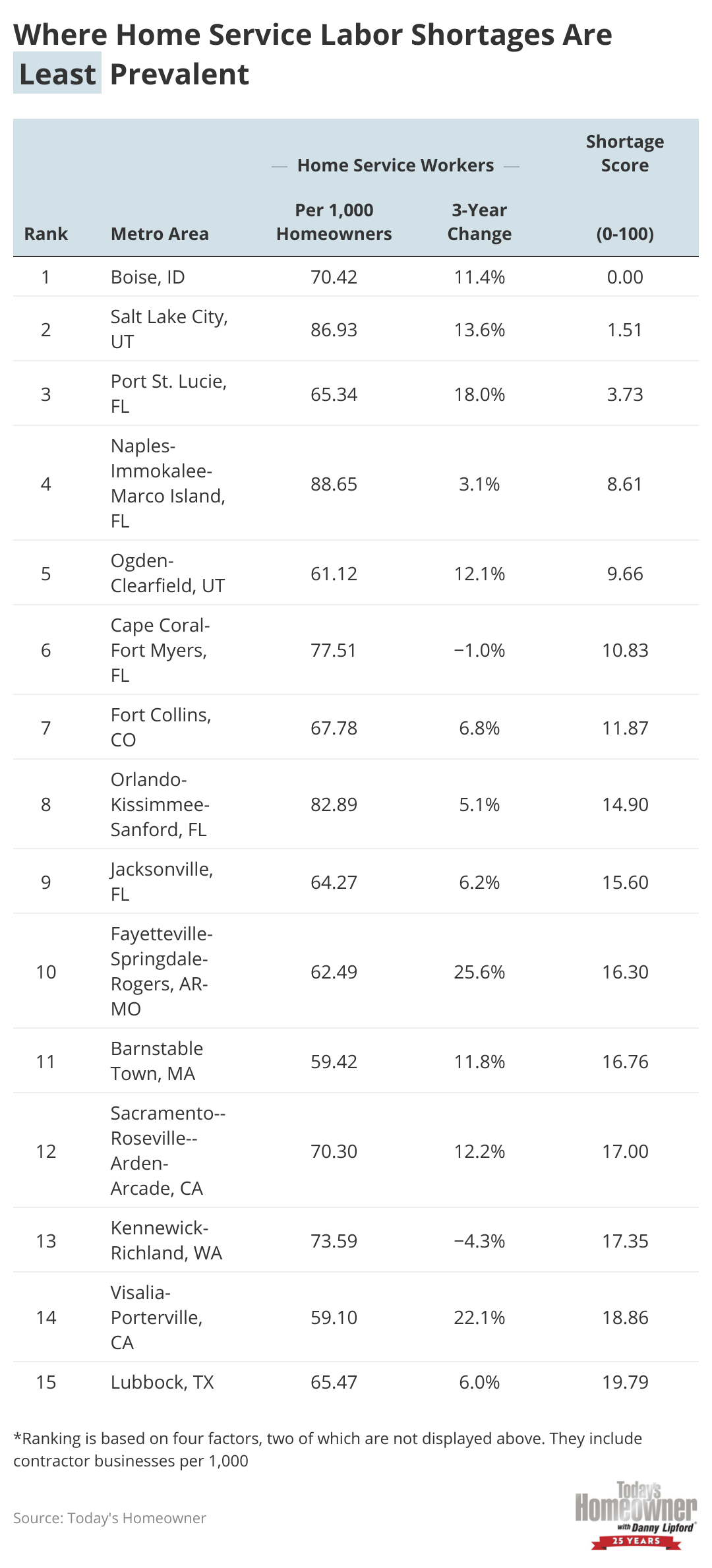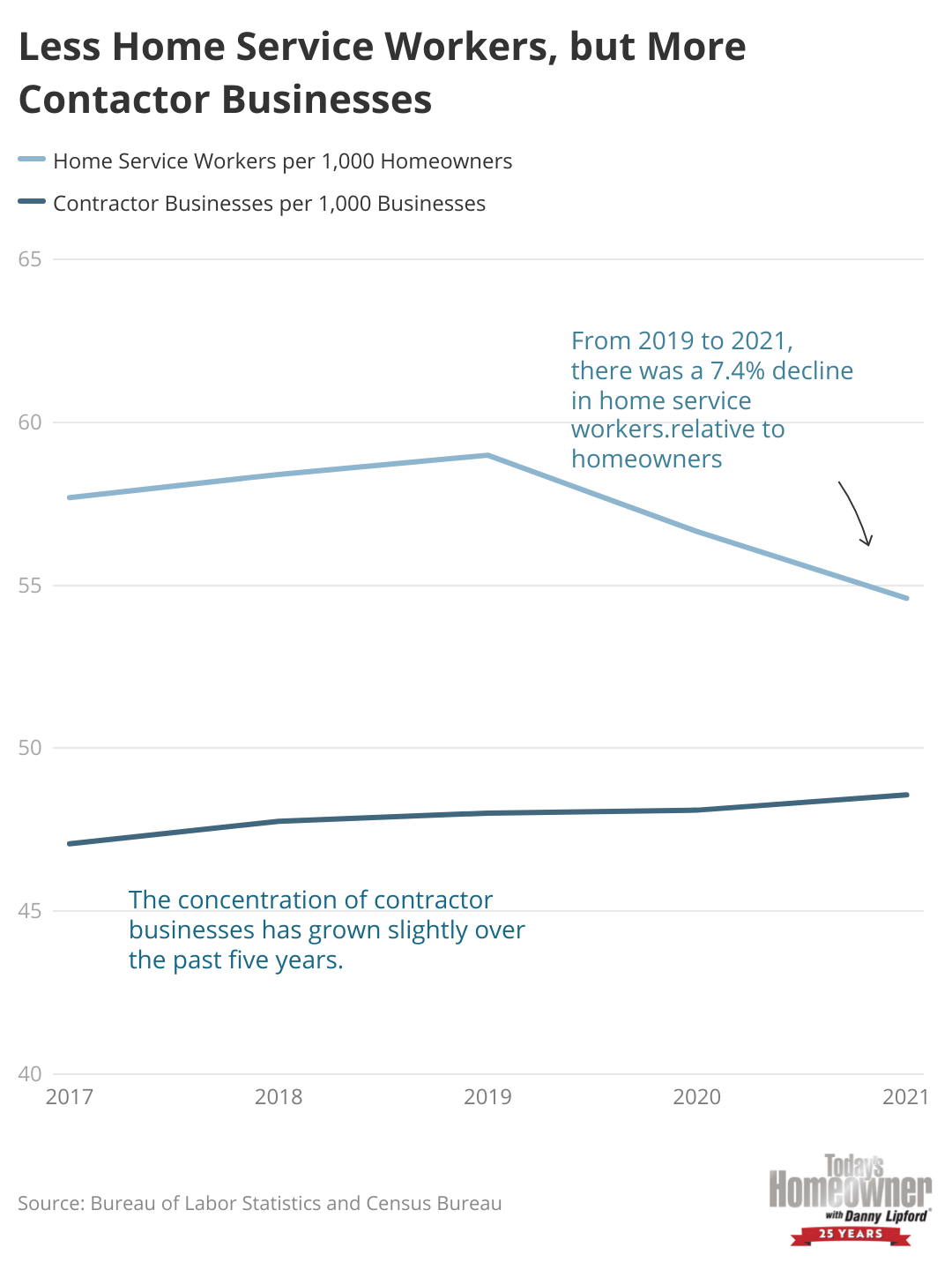Where homeowners are most impacted by the skilled labor shortage

Canva
Where homeowners are most impacted by the skilled labor shortage
Contractor assembling new kitchen cabinets.
With recent news of Home Depot and Lowe’s earnings losses, we’re starting to see a downward trend in home improvement spending. But there’s no doubt the home services industry saw a strong 2022. According to Harvard University’s Joint Center for Housing Studies data, Americans spent close to $500 billion on home improvements in 2022, marking a decade of continuous growth within the industry.
However, with pent-up demand from the COVID-19 pandemic and increasing labor shortages across all sectors, many homeowners struggled to find professional help for their construction needs. This has left homeowners to face remodels or even critical repairs themselves. In places where demand and supply are mismatched, homeowners may need to turn to DIY projects more often, brace for remodeling wait times, or even pay a premium on home contractor services.
To find out where skilled labor shortages are affecting homeowners the most, Today’s Homeowner used data from the Bureau of Labor Statistics and the Census Bureau to create a proprietary ranking of where home service labor shortages are most and least prevalent. Additionally, researchers dug into home improvement trends, analyzing national labor and contractor business changes over the past several years.
Main Findings
- Rust Belt areas are more likely to feel the squeeze. Metro areas in West Virginia, Pennsylvania, Illinois, and Ohio all rank in the 10 places where labor shortages may most impact homeowners.
- Homeowners in Florida are feeling skilled labor shortages the least. Five of the top 10 places with the fewest skilled labor shortages are in the Sunshine State.
- Since 2019, there has been a 7% decline in the number of home service workers relative to homeowners and BLS data suggests labor shortages may worsen over the coming decade.
- Out of the eight skilled trade jobs analyzed, home inspectors is the only occupation with a negative 10-year projected job growth rate (-4.4%), spelling trouble for both buyers and sellers alike.
![]()

Today’s Homeowner
Where Are Home Service Labor Shortages the Worst?
A table listing the 15 metro areas where home service labor shortages are most prevalent.
Though home service labor shortages are widespread, the study found uneven availability of where skilled help can be found for homeowners. Nationally, there are approximately 55 home service workers per 1,000 homeowners, but the figure does not break 40 in 19 metro areas.
As previously noted, many of the places where homeowners may have the most trouble finding professional help are in the Rust Belt. Beyond that, several metro areas in Southern states are represented. Across the 30 worst-ranking metro areas, five are in Texas and three in Alabama (including Columbus, GA-AL, which spans Georgia and Alabama).

Today’s Homeowner
Where Home Service Labor Shortages Are Least Prevalent
A table listing the 15 metro areas where home service labor shortages are least prevalent.
In some areas, finding professional help for your home improvement projects may be much easier. Beyond ranking the places where home service labor shortages are most prevalent, the study also looked at where they are least prevalent.
Two Western metro areas top the list: Boise, Idaho and Salt Lake City, Utah. There are more than 70 home service workers per 1,000 homeowners in both places, and the number of home service workers is growing in these cities.

Today’s Homeowner
Fewer Workers, More Businesses
A line chart of the concentration of home service workers per 1,000 homeowners and of contractor businesses per 1,000 businesses, where home service workers became 7.4% fewer from 2019 to 2021 but contractor businesses became slightly more common.
Across the country, there have been widespread complaints of labor shortages post-pandemic, leading to home repairs and improvement help backlogs. The data shows homeowners are picking up on a very real decline in home service workers. In 2019, there were roughly 59 home service workers for every 1,000 homeowners, compared to less than 55 in 2021. This marks a 7% decline over two years.
Contrasting the trend of fewer home service workers, the concentration of contractor businesses has slightly grown. In 2017, there were 47.07 contractor businesses per 1,000 businesses nationally and in 2021, that figure stood at 48.57 — an increase of roughly 3% over the five years.

Today’s Homeowner
Muted Job Growth Expected Over the Next Decade
A bar chart showing the 10-year projected job growth for a range of home services workers.
The gap between demand and supply in home services may continue to grow over the next decade. Data from the BLS shows that job growth is expected to be slower than the national average (5.3%) in six of the eight home service jobs we considered.
The two exceptions are electricians and pest control workers. From 2021 to 2031, the BLS projects that the number of electricians and pest control workers will grow by 7.1% and 6.8%, respectively.
Of the home service jobs with slower expected growth, home inspectors ranks last. The BLS projects that there will be 4.4% fewer home inspectors in 2031 than in 2021. This is likely to have a huge impact on home sellers and buyers, both of whom need inspectors when selling or buying homes.
Methodology
To determine where labor shortages affect homeowners the most, Today’s Homeowner compared 198 of the 200 largest metro areas with complete available data. Accounting for both the number of home service workers along with the number of businesses serving homeowner needs, the study compared metro areas across four key metrics:
- Home services workers per 1,000 homeowners. Data comes from the Bureau of Labor Statistics’ 2022 Occupational Employment Survey and the Census Bureau’s 2021 1-year American Community Survey.
- Three-year change in number of home service workers. Data comes from the Bureau of Labor Statistics’ 2019 and 2022 Occupational Employment Surveys.
- Contractor businesses per 1,000 businesses. Data comes from the Census Bureau’s 2021 County Business Patterns Survey.
- Three-year change in the number of contractor businesses. Data comes from the Census Bureau’s 2018 and 2021 County Business Patterns Surveys.
The study calculated an average ranking using the four metrics, double-weighting home service workers per 1,000 homeowners and single-weighting all other metrics. The city where home service labor shortages are most prevalent scored 100, and vice versa.
This story was produced by Today’s Homeowner and reviewed and distributed by Stacker Media.





